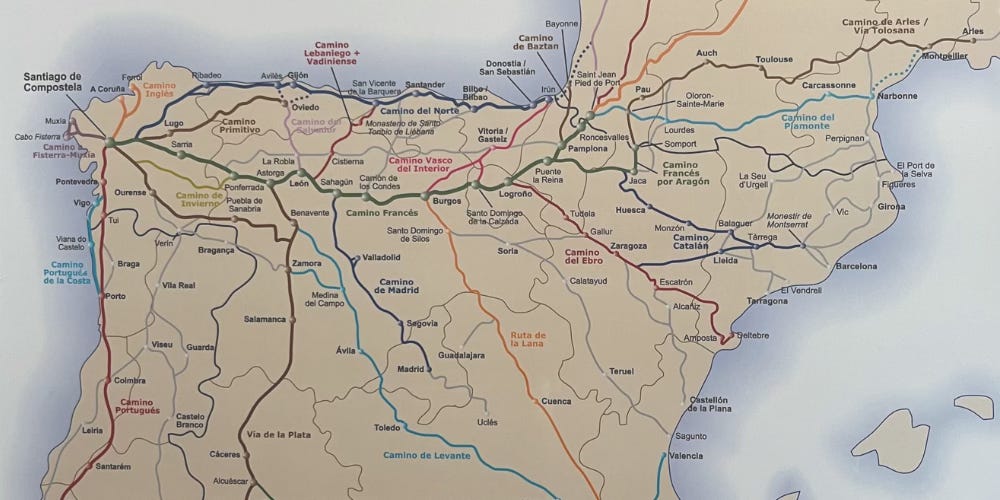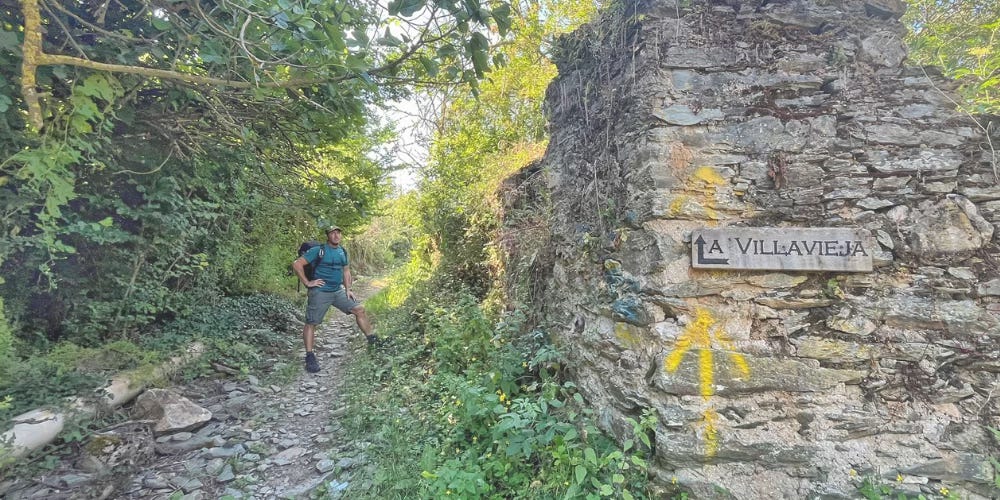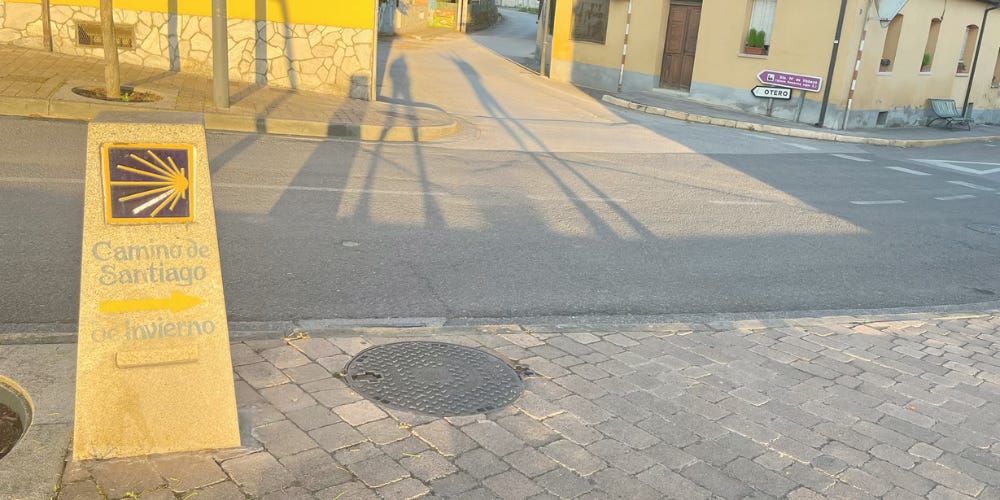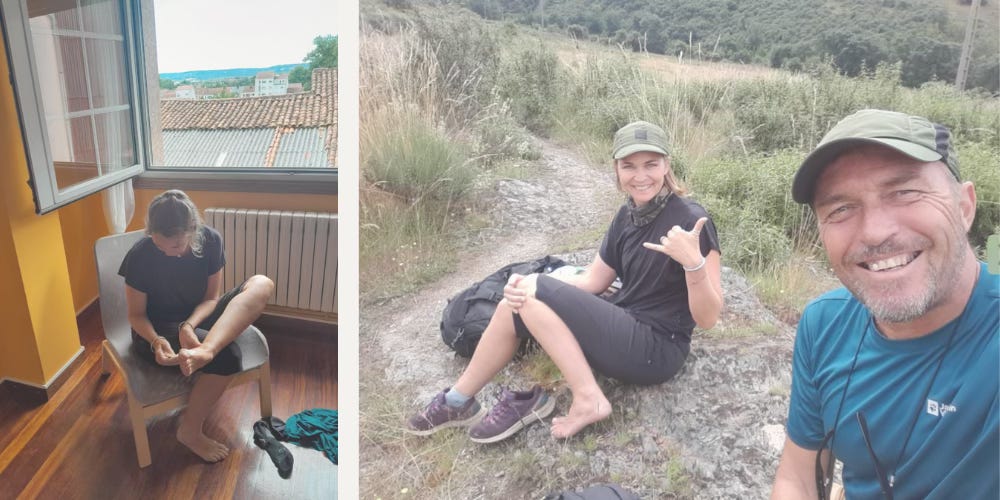If you’ve arrived here from somewhere on the web, welcome! NE Where is a an independent, travel-focussed journal for curious people. If you’d like to receive pieces like this one via email, please consider becoming a subscriber. It’s free – or, for less than $1 a week, upgrade to a paid subscription, where benefits include full access to NE Where’s archive, which is packed with stories about exceptional women, and other tales about interesting people and places).
Q&A from along ‘The Way’
Busy day? Listen to this message, instead of reading it:
Dear NE-One
I’m writing to you while sitting at my grandmother’s round oak table. It seats four people, and fits perfectly into the curve of our modest dining area – and it’s here that I work from whenever I am home. The gentle almost-autumn sun is warming my back, and I feel grounded, surrounded as I am by old furniture and books and things that have stories.
After a wild ride of intense deadlines and then the much-needed silence of our walk through Spain, my mind is once again starting to find its rhythm, and words are beginning to flow from my fingers.
I’ve been lining up some interesting stories – and people – to share with you in the coming weeks, but as I’ve received so many questions about walking a Camino, I wanted to share some insights with you. If walking in Spain is on your radar, the details below (no, this isn’t a guide) might be useful…
Did you walk ‘The’ Camino?

No – we walked ‘A’ Camino. It’s a common misconception that there’s just one route, but as you can see in the map above, there are so many that lead to Santiago de Compostela, the ultimate destination for the pilgrim trails. The most popular is the 680km-long Camino Frances, the French Way (the dark green route, above); close on half a million people walk this route, or part of it, each year. In mid-May Mark and I drove through an area that this route passes, and we counted 70 pilgrims walking along a 3km stretch of road. If you’re looking for solitude, this isn’t the route for you.
Mark and I walked two days of the French route, from Astorga to Ponferrada, and then we set off on the incredibly beautiful 263km-long Camino de Invierno, the Winter Way, which is walked by around only 2,000 people each year. Most days we didn’t see another pilgrim on the trail, but we did begin to recognize faces in the towns we stayed in; we figured there were eight people (including Mark and me) walking the same(ish) stage each day.
Which Camino route is the most beautiful?
This is something I asked Pedro, a Portuguese guy we met one evening. He’s walked 16 Caminoes (some routes more than once) and, as I’d been mulling over which route we should walk next, I was keen to hear Pedro’s opinion. “The most beautiful? That’s impossible to say,” he said. “Every Camino is different, and every Camino will be shaped by the people you meet. The landscape really doesn’t matter; people do.”
How did you know where to go?
The Camino routes are very well marked: just keep an eye out for the yellow arrows, and you’ll make it to Santiago. There are also many guidebooks and apps that describe the routes in intricate detail. We met an Irish guy called Chris who’s walked 12 (or was it 16?) Caminoes, and he swears by the printed guides written by John Brierley; Mark was using the popular Wise Pilgrim app. Wise Pilgrim sell printed guides too.
Is it expensive to walk a Camino?

There are so many variables – how long is your walk, what level of accommodation do you want to stay in, how much wine do you plan on drinking? The cheapest beds are in albergues (hostels for pilgrims), which cost from €10 a night; you’ll pay about €30 a night for a double room in a pension (a hostel with dorms as well as private rooms); hotels are upwards of €50 a night.
If you plan on walking to Santiago and are on a tight budget: book your accommodation in Santiago as soon as you can. There are many hundreds (and in the height of summer, more than 2000) pilgrims who walk into the city every day: accommodation can be hard to find, and it comes with a hefty price tag. We booked about three days before we arrived; there was very little available and even the most mediocre double room cost €100.
You can buy a loaf of bread in a supermarket for around €0.60, and a pack of jamon will cost from €1; a glass of wine or a coffee in a café is about €1.20; a menu del dia (a set three-course menu in a café) is from about €8, including wine. Water you can get for free in many villages, where drinking fountains have been quenching thirsts for centuries.
Here’s a tip: always carry cash in small denominations as, particularly along the French and Portuguese routes, there are many donativos – donation-based stalls beside the trail that offer pilgrims fruit, snacks and drinks.
What was the most useful thing you carried?
My sarong. I used it as a picnic blanket, a bed sheet, a towel, for sun protection and, on one chilly evening in the mountains, a scarf. Also very useful was my twisted-elastic clothes line (we washed sweaty clothes almost every day) and the lightweight insulating jacket Jack Wolfskin sent me, which I wore every morning.
Did you get any blisters?
Yes – my own fault, as I’d tried a fancy new lacing technique the first morning we set off. The rest of the walk I focussed on BPM - ‘blister prevention management’. Here are four valuable lessons I learned:
1) Soft feet are happy feet. About a week or so before you begin your walk, smother your feet with Vaseline or body lotion before you go to bed, and sleep with socks on. This will soften the skin and reduce the chances of getting blisters. Common practice among adventure racers, says Shale Biggs.
2) Another tip from adventure racers: Leukotape is brilliant for blister prevention. Every morning I’d tape the balls of my feet, which are my usual blister hotspots, and they remained blister-free.
3) Before you set off, consider how many kilometres you’ve already walked in your shoes. I’m not an athlete and doubt I’ve ever worn out the soles of running shoes before, so I didn’t think to check the condition of my Merrell trail shoes before we set off. After about 120km I bought a new pair of insoles (and felt like I was walking on a cloud!), and in the last 80km or so I became acutely aware that the outer soles were wearing uncomfortably thin. Experienced trail runners expect to get between 700km and 1000km from a pair of trail shoes.
4) Next time I’ll take a pair of good sports sandals to wear instead of flip-flops for when the day’s walk is done. I saw a few people walking in them too – and met Gary, who’s walked 13 different Camino routes wearing only sports sandals.
How far did you walk every day?

I think we averaged about 25km a day – but the distances you will walk will depend on your route. Along the French Way, for example, you’ll frequently come across villages where there is accommodation and so you can walk shorter distances; on our Winter Way, there was one day where there was 35km between villages that have accommodation. The various Camino guides and apps available are usually brilliant with this sort of info.
I probably won’t be sharing more details here about the walk, but you’re welcome to drop me a line if you’re contemplating a walk along one of the Camino routes – I’m happy to answer any questions you have.
Until next time,
Narina x
NE Where is an independent, reader-supported publication. If you found value in this piece please consider becoming a subscriber, sharing this post with someone who might enjoy it, or perhaps buying me a (virtual) coffee.















Loved this, very informative.
After walking three Camino Frances, I can safely say-no more. Wayyy to busy nowadays. I've heard only good things about the Invierno, and hope walk it by way of the Via de la Plata from Seville. The one camino I absolutely loved was the Podienis, starting from Le Puy France...gorgeous villages and landscape!